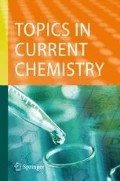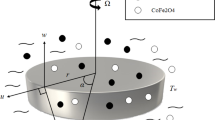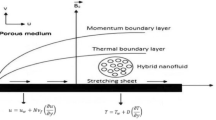Abstract
Sonochemistry refers to ultrasound-initiated chemical processes in liquids. The interaction between bubbles and sound energy in liquids results in acoustic cavitation. This review presents the fundamental aspects of acoustic cavitation and theoretical aspects behind sonochemistry such as dynamics of bubble oscillation, the rectified diffusion process that is responsible for the growth of cavitation bubbles, near adiabatic collapse of cavitation bubbles resulting in extreme reaction conditions and several chemical species generated within collapsing bubbles that are responsible for various redox reactions. Specifically, a detailed discussion on single bubble sonochemistry is provided.

















Similar content being viewed by others
References
Ashokkumar M, Mason TJ (2007) Sonochemistry. In: Kirk-Othmer encyclopedia of chemical technology. Wiley, New York. doi:10.1002/0471238961.1915141519211912.a01.pub2
Duckhouse H, Mason T, Phull S, Lorimer J (2004) The effect of sonication on microbial disinfection using hypochlorite. Ultrason Sonochem 11:173–176
Ferrara K, Pollard R, Borden M (2007) Ultrasound microbubble contrast agents: fundamentals and application to gene and drug delivery. Biomed Eng 9:415–447
Thornycroft JI, Barnaby SW (1895) Torpedo-boat destroyers. In: Minutes of the proceedings of the Institution of Civil Engineers, Thomas Telford-ICE Virtual Library, pp 51–69
Rayleigh L (1917) VIII. On the pressure developed in a liquid during the collapse of a spherical cavity. Lond Edinb Dubl Phil Mag 34:94–98
Brohult S (1937) Splitting of the haemocyanin molecule by ultrasonic waves. Nature 140:805
Frenzel H, Schultes HF (1935) Luminescenz im Ultraschallbeschickten Wasser. Z Phys Chem 27:421
Weiss J (1944) Radiochemistry of aqueous solutions. Nature 153:48–50
Parke A, Taylor D (1956) The chemical action of ultrasonic waves. J Chem Phys (Resumed) 1956:4442–4450. doi:10.1039/JR9560004442
Schulz R, Henglein A (1953) Notizen: Über den Nachweis von freien Radikalen, die unter dem Einfluß von Ultraschallwellen gebildet werden, mit Hilfe von Radikal-Kettenpolymerisation und Diphenyl-pikryl-hydrazyl. Zeitschrift für Naturforschung B 8:160–161
Noltingk BE, Neppiras EA (1950) Cavitation produced by ultrasonics. Proc Phys Soc Sect B 63:674
Makino K, Mossoba MM, Riesz P (1983) Chemical effects of ultrasound on aqueous solutions. Formation of hydroxyl radicals and hydrogen atoms. J Phys Chem 87:1369–1377
Henglein A (1987) Sonochemistry: historical developments and modern aspects. Ultrasonics 25:6–16
Leighton T (2012) The acoustic bubble. Academic, San Diego
Lorimer JP, Mason TJ (1987) Sonochemistry. Part 1—the physical aspects. Chem Soc Rev 16:239–274
Mason T, Paniwnyk L, Lorimer J (1996) The uses of ultrasound in food technology. Ultrason Sonochem 3:S253–S256
Mason TJ, Lorimer JP (1989) An introduction to sonochemistry. Endeavour 13:123–128
Leong T, Wu S, Kentish S, Ashokkumar M (2010) Growth of bubbles by rectified diffusion in aqueous surfactant solutions. J Phys Chem C 114:20141–20145
Ashokkumar M (2016) Ultrasonic synthesis of functional materials. In: SpringerBriefs in green chemistry for sustainability. Springer, Cham, pp 17–40
Crum LA (1982) Nucleation and stabilization of microbubbles in liquids. Appl Sci Res 38:101–115
Ashokkumar M (2010) Theoretical and experimental sonochemistry involving inorganic systems. Springer, Dordrecht
Yount DE (1979) Skins of varying permeability: a stabilization mechanism for gas cavitation nuclei. J Acoust Soc Am 65:1429–1439
Lim M, Ashokkumar M, Son Y (2014) The effects of liquid height/volume, initial concentration of reactant and acoustic power on sonochemical oxidation. Ultrason Sonochem 21:1988–1993
Crum L (1984) Acoustic cavitation series: part five rectified diffusion. Ultrasonics 22:215–223
Yasui K, Tuziuti T, Kanematsu W, Kato K (2016) Dynamic equilibrium model for a bulk nanobubble and a microbubble partly covered with hydrophobic material. Langmuir. doi:10.1021/acs.langmuir.5b04703
Yasui K (2002) Influence of ultrasonic frequency on multibubble sonoluminescence. J Acoust Soc Am 112:1405–1413
Bremond N, Arora M, Dammer SM, Lohse D (2006) Interaction of cavitation bubbles on a wall. Phys Fluids 18:121505
Yount D, Gillary E, Hoffman D (1984) A microscopic investigation of bubble formation nuclei. J Acoust Soc Am 76:1511–1521
Calvisi ML, Lindau O, Blake JR, Szeri AJ (2007) Shape stability and violent collapse of microbubbles in acoustic traveling waves. Phys Fluids 19:047101
Wang W, Chen W, Lu M, Wei R (2003) Bubble oscillations driven by aspherical ultrasound in liquid. J Acoust Soc Am 114:1898–1904
Plesset M (1949) The dynamics of cavitation bubbles. J Appl Mech 16:277–282
Poritsky P (1952) The collapse or growth of a spherical bubble or cavity in a viscous fluid. In: Proceedings of the 1st US National Congress in Applied Mathematics, p 813
Tomita Y, Shima A (1986) Mechanisms of impulsive pressure generation and damage pit formation by bubble collapse. J Fluid Mech 169:535–564
Yasui K (1998) Effect of non-equilibrium evaporation and condensation on bubble dynamics near the sonoluminescence threshold. Ultrasonics 36:575–580
Grieser F, Ashokkumar M (2006) Sonochemical synthesis of inorganic and organic colloids. In: Caruso F (ed) Colloids and colloid assemblies: synthesis, modification, organization and utilization of colloid particles. Wiley-VCH, Weinheim, pp 120–149
Hsieh DY, Plesset MS (1961) Theory of rectified diffusion of mass into gas bubbles. J Acoust Soc Am 33:206–215
Eller A, Flynn H (1965) Rectified diffusion during nonlinear pulsations of cavitation bubbles. J Acoust Soc Am 37:493–503
Fyrillas MM, Szeri AJ (1996) Surfactant dynamics and rectified diffusion of microbubbles. J Fluid Mech 311:361–378
Lee J, Kentish S, Ashokkumar M (2005) Effect of surfactants on the rate of growth of an air bubble by rectified diffusion. J Phys Chem B 109:14595–14598
Vinodgopal K, He Y, Ashokkumar M, Grieser F (2006) Sonochemically prepared platinum-ruthenium bimetallic nanoparticles. J Phys Chem B 110:3849–3852
Anandan S, Grieser F, Ashokkumar M (2008) Sonochemical synthesis of Au−Ag core− shell bimetallic nanoparticles. J Phys Chem C 112:15102–15105
Kumar PSS, Manivel A, Anandan S, Zhou M, Grieser F, Ashokkumar M (2010) Sonochemical synthesis and characterization of gold–ruthenium bimetallic nanoparticles. Colloids Surf A Physicochem Eng Asp 356:140–144
Lee J, Ashokkumar M, Kentish S, Grieser F (2005) Determination of the size distribution of sonoluminescence bubbles in a pulsed acoustic field. J Am Chem Soc 127:16810–16811
Brotchie A, Grieser F, Ashokkumar M (2009) Effect of power and frequency on bubble-size distributions in acoustic cavitation. Phys Rev Lett 102:084302
Burdin F, Tsochatzidis N, Guiraud P, Wilhelm A, Delmas H (1999) Characterisation of the acoustic cavitation cloud by two laser techniques. Ultrason Sonochem 6:43–51
Chen W-S, Matula TJ, Crum LA (2002) The disappearance of ultrasound contrast bubbles: observations of bubble dissolution and cavitation nucleation. Ultrasound Med Biol 28:793–803
Tsochatzidis N, Guiraud P, Wilhelm A, Delmas H (2001) Determination of velocity, size and concentration of ultrasonic cavitation bubbles by the phase-Doppler technique. Chem Eng Sci 56:1831–1840
Yasui K, Tuziuti T, Kozuka T, Towata A, Iida Y (2007) Relationship between the bubble temperature and main oxidant created inside an air bubble under ultrasound. J Chem Phys 127:154502
Merouani S, Hamdaoui O, Rezgui Y, Guemini M (2014) Theoretical estimation of the temperature and pressure within collapsing acoustical bubbles. Ultrason Sonochem 21:53–59
Mišík V, Miyoshi N, Riesz P (1995) EPR spin-trapping study of the sonolysis of H2O/D2O mixtures: probing the temperatures of cavitation regions. J Phys Chem 99:3605–3611
Suslick KS, Hammerton DA, Cline RE (1986) Sonochemical hot spot. J Am Chem Soc 108:5641–5642
Hart EJ, Fischer C-H, Henglein A (1990) Sonolysis of hydrocarbons in aqueous solution. Int J Radiat Appl Instrum C Radiat Phys Chem 36:511–516
Tauber A, Mark G, Schuchmann H-P, Sonntag C (1999) Sonolysis of tert-butyl alcohol in aqueous solution. J Chem Soc Perkin Trans 2:1129–1136
Rae J, Ashokkumar M, Eulaerts O, von Sonntag C, Reisse J, Grieser F (2005) Estimation of ultrasound induced cavitation bubble temperatures in aqueous solutions. Ultrason Sonochem 12:325–329
Ciawi E, Rae J, Ashokkumar M, Grieser F (2006) Determination of temperatures within acoustically generated bubbles in aqueous solutions at different ultrasound frequencies. J Phys Chem B 110:13656–13660
Crum L (1994) Sonoluminescence, sonochemistry, and sonophysics. J Acoust Soc Am 95:559–562
Mason TJ, Peters D (2002) Practical sonochemistry: power ultrasound uses and applications. Woodhead, Cambridge
Ashokkumar M, Lee J, Kentish S, Grieser F (2007) Bubbles in an acoustic field: an overview. Ultrason Sonochem 14:470–475
Marinesco M, Trillat JJ (1933) Action des ultrasons sur les plaques photographiques. CR Acad Sci Paris 196:858
Griffing V, Sette D (1955) Luminescence produced as a result of intense ultrasonic waves. J Phys Chem 23:503–509
Suslick KS, Crum LA (1998) Sonochemistry and sonoluminescence. Wiley-Interscience, New York
Yasui K (1999) Mechanism of single-bubble sonoluminescence. Phys Rev E 60:1754
An Y (2006) Mechanism of single-bubble sonoluminescence. Phys Rev E 74:026304
Jarman P (1958) Sonoluminescence. Sci Prog 46:632–639
Crum L, Walton A, Mortimer A, Dyson M, Crawford D, Gaitan D (1987) Free radical production in amniotic fluid and blood plasma by medical ultrasound. J Utras Med 6:643–647
Finch R (1963) Sonoluminescence. Ultrasonics 1:87–98
Weissler A (1953) Sonochemistry: the production of chemical changes with sound waves. J Acoust Soc Am 25:651–657
Chendke P, Fogler H (1983) Sonoluminescence and sonochemical reactions of aqueous carbon tetrachloride solutions. J Phys Chem 87:1362–1369
Chambers LA (1937) The emission of visible light from cavitated liquids. J Chem Phys 5:290–292
Wu C, Roberts PH (1993) Shock-wave propagation in a sonoluminescing gas bubble. Phys Rev Lett 70:3424
Moss WC, Clarke DB, White JW, Young DA (1994) Hydrodynamic simulations of bubble collapse and picosecond sonoluminescence. Phys Fluids 6:2979–2985
Kondić L, Gersten JI, Yuan C (1995) Theoretical studies of sonoluminescence radiation: radiative transfer and parametric dependence. Phys Rev E 52:4976
Kwak H-Y, Na JH (1996) Hydrodynamic solutions for a sonoluminescing gas bubble. Phys Rev Lett 77:4454
Yasui K (1997) Alternative model of single-bubble sonoluminescence. Phys Rev E 56:6750
Yasui K (1999) Single-bubble and multibubble sonoluminescence. Phys Rev Lett 83:4297
S-i Hatanaka, Mitome H, Yasui K, Hayashi S (2002) Single-bubble sonochemiluminescence in aqueous luminol solutions. J Am Chem Soc 124:10250–10251
Ashokkumar M (2011) The characterization of acoustic cavitation bubbles—an overview. Ultrason Sonochem 18:864–872
Ashokkumar M, Lee J, Iida Y, Yasui K, Kozuka T, Tuziuti T, Towata A (2010) Spatial distribution of acoustic cavitation bubbles at different ultrasound frequencies. ChemPhysChem 11:1680–1684
Sunartio D, Yasui K, Tuziuti T, Kozuka T, Iida Y, Ashokkumar M, Grieser F (2007) Correlation between Na* emission and “chemically active” acoustic cavitation bubbles. ChemPhysChem 8:2331–2335
Mišík V, Riesz P (1996) EPR study of free radicals induced by ultrasound in organic liquids II. Probing the temperatures of cavitation regions. Ultrason Sonochem 3:25–37
Mišík V, Riesz P (1996) Recent applications of EPR and spin trapping to sonochemical studies of organic liquids and aqueous solutions. Ultrason Sonochem 3:S173–S186
Mason T, Lorimer J, Bates D, Zhao Y (1994) Dosimetry in sonochemistry: the use of aqueous terephthalate ion as a fluorescence monitor. Ultrason Sonochem 1:S91–S95
Ashokkumar M, Niblett T, Tantiongco L, Grieser F (2003) Sonochemical degradation of sodium dodecylbenzene sulfonate in aqueous solutions. Aust J hem 56:1045–1049
Ashokkumar M, Grieser F (2005) A comparison between multibubble sonoluminescence intensity and the temperature within cavitation bubbles. J Am Chem Soc 127:5326–5327
S-i Hatanaka, Yasui K, Kozuka T, Tuziuti T, Mitome H (2002) Influence of bubble clustering on multibubble sonoluminescence. Ultrasonics 40:655–660
Kanthale P, Ashokkumar M, Grieser F (2008) Sonoluminescence, sonochemistry (H2O2 yield) and bubble dynamics: frequency and power effects. Ultrason Sonochem 15:143–150
Yasui K (2001) Temperature in multibubble sonoluminescence. J Chem Phys 115:2893–2896
Weninger K, Camara C, Putterman S (2000) Observation of bubble dynamics within luminescent cavitation clouds: sonoluminescence at the nano-scale. Phys Rev E 63:016310
Yasui K, Tuziuti T, Sivakumar M, Iida Y (2005) Theoretical study of single-bubble sonochemistry. J Chem Phys 122:224706
Didenko YT, Suslick KS (2002) The energy efficiency of formation of photons, radicals and ions during single-bubble cavitation. Nature 418(6896):394–397
Matula TJ, Crum LA (1998) Evidence for gas exchange in single-bubble sonoluminescence. Phys Rev Lett 80:865
Kruus P (2000) Sonochemical formation of nitrate and nitrite in water. Ultrason Sono 7:109–113
Koda S, Tanaka K, Sakamoto H, Matsuoka T, Nomura H (2004) Sonochemical efficiency during single-bubble cavitation in water. J Phys Chem A 108:11609–11612
Yasui K, Tuziuti T, Iida Y, Mitome H (2003) Theoretical study of the ambient-pressure dependence of sonochemical reactions. J Chem Phys 119:346–356
Vazquez G, Camara C, Putterman S, Weninger K (2001) Sonoluminescence: nature’s smallest blackbody. Opt Lett 26:575–577
Tuziuti T, Yasui K, Sivakumar M, Iida Y, Miyoshi N (2005) Correlation between acoustic cavitation noise and yield enhancement of sonochemical reaction by particle addition. J Phys Chem A 109:4869–4872
Matula TJ, Roy RA, Mourad PD, McNamara WB III, Suslick KS (1995) Comparison of multibubble and single-bubble sonoluminescence spectra. Phys Rev Lett 75:2602
Mettin R, Akhatov I, Parlitz U, Ohl C, Lauterborn W (1997) Bjerknes forces between small cavitation bubbles in a strong acoustic field. Phys Rev E 56:2924
Lucien E, Greer A (2001) Electrophilic oxidant produced in the photodeoxygenation of 1,2-benzodiphenylene sulfoxide. J Org Chem 66:4576–4579
Brown WG, Hart EJ (1972) The oxygen atom: a primary species in irradiated water. Radiat Res 51:249–253
Sauer MC Jr, Brown WG, Hart EJ (1984) Oxygen (3P) atom formation by the photolysis of hydrogen peroxide in alkaline aqueous solutions. J Phys Chem 88:1398–1400
Hart EJ, Henglein A (1985) Free radical and free atom reactions in the sonolysis of aqueous iodide and formate solutions. J Phys Chem 89:4342–4347
Thomas KB, Greer A (2003) Gauging the significance of atomic oxygen [O(3P)] in sulfoxide photochemistry. A method for hydrocarbon oxidation. J Org Chem 68:1886–1891
Yasui K (2001) Effect of liquid temperature on sonoluminescence. Phys Rev E 64:016310
Toegel R, Gompf B, Pecha R, Lohse D (2000) Does water vapor prevent upscaling sonoluminescence? Phys Rev Lett 85:3165
Yasui K, Tuziuti T, Iida Y (2004) Optimum bubble temperature for the sonochemical production of oxidants. Ultrasonics 42:579–584
Beckett MA, Hua I (2001) Impact of ultrasonic frequency on aqueous sonoluminescence and sonochemistry. J Phys Chem A 105:3796–3802
Capocelli M, Joyce E, Lancia A, Mason TJ, Musmarra D, Prisciandaro M (2012) Sonochemical degradation of estradiols: incidence of ultrasonic frequency. Chem Eng J 210:9–17
Petrier C, Jeunet A, Luche JL, Reverdy G (1992) Unexpected frequency effects on the rate of oxidative processes induced by ultrasound. J Am Chem Soc 114:3148–3150
Ashokkumar M, Sunartio D, Kentish S, Mawson R, Simons L, Vilkhu K, Versteeg CK (2008) Modification of food ingredients by ultrasound to improve functionality: a preliminary study on a model system. Innov Food Sci Emerg 9:155–160
Shanmugam A, Chandrapala J, Ashokkumar M (2012) The effect of ultrasound on the physical and functional properties of skim milk. Innov Food Sci Emer 16:251–258
Ashokkumar M, Lee J, Zisu B, Bhaskarcharya R, Palmer M, Kentish S (2009) Hot topic: sonication increases the heat stability of whey proteins. J Dairy Sci 92:5353–5356
Chandrapala J, Zisu B, Palmer M, Kentish S, Ashokkumar M (2011) Effects of ultrasound on the thermal and structural characteristics of proteins in reconstituted whey protein concentrate. Ultrason Sonochem 18:951–957
Price GJ (1996) Ultrasonically enhanced polymer synthesis. Ultrason Sonochem 3:S229–S238
Bhangu SK, Ashokkumar M, Lee J (2016) Ultrasound assisted crystallization of paracetamol: crystal size distribution and polymorph control. Crys Growth Des 16:1934–1941
Mason TJ (2003) Sonochemistry and sonoprocessing: the link, the trends and (probably) the future. Ultrason Sonochem 10:175–179
Author information
Authors and Affiliations
Corresponding author
Additional information
This article is part of the Topical Collection “Sonochemistry: From basic principles to innovative applications”; edited by Juan Carlos Colmenares Q., Gregory Chatel.
Rights and permissions
About this article
Cite this article
Bhangu, S.K., Ashokkumar, M. Theory of Sonochemistry. Top Curr Chem (Z) 374, 56 (2016). https://doi.org/10.1007/s41061-016-0054-y
Received:
Accepted:
Published:
DOI: https://doi.org/10.1007/s41061-016-0054-y




